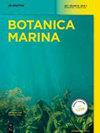印度孙德尔本斯地区 Cerataulina 静止孢子形态变异的流行历史及由此产生的系统发育分析
IF 1.4
4区 生物学
Q2 MARINE & FRESHWATER BIOLOGY
引用次数: 0
摘要
本文介绍了硅藻 Cerataulina 静止孢子的 15 种形态变体的形态特征,以及它们在印度孙德尔本斯不同生境的时空分布情况。空间系统包括浮游植物群、河岸表层沉积物和邻近三角洲陆地不同深度的短沉积物岩心。时间系统的时间跨度为公元前 2000 年至今。虽然 Cerataulina 作为孙德尔本斯的一种浮游生物形式在一些出版物中被零星提及,但这是首次报道其在不同栖息地的不同静止孢子。沉积物岩芯中的 14C 测定和计算年龄表明,它们在该系统中的存在时间为公元前 1996 年。有趣的是,即使静止孢子在整个空间和时间范围内都非常普遍,但在从 2013 年 2 月到 2023 年 3 月的 9 年时间里,浮游植物群中只能偶尔记录到活体无性阶段。利用戴斯相似系数对 Cerataulina 静止孢子的形态变化进行聚类分析,该方法基于非加权成对分组法,以算术平均值表示系统发育关系。结果突出显示了静止孢子形态的两个主要聚类,即 Cerataulina bicornis(syn = Cerataulina daemon)和 Syringidium simplex。本文章由计算机程序翻译,如有差异,请以英文原文为准。
Prevalence history of morphological variants of Cerataulina resting spores in Indian Sundarbans and resultant phylogenetic analysis
Fifteen morphological variants of resting spores of the diatom Cerataulina are presented with morphometric characters and presence in different habitats over spatial and temporal regimes in the Indian Sundarbans. Spatial regime includes phytoplankton assemblages, river-bank surface sediments and different depths of short sediment cores of adjacent deltaic landmasses. The temporal regime spans a period of 2000 years BP to present times. Though Cerataulina is sporadically mentioned in a few publications as a planktonic form in the Sundarbans, this is the first report of its different resting spores from different habitats. The 14 C dating and calculated age within sediment cores suggest their existence in the system for 1996 years BP. Interestingly, even with the significant prevalence of resting spores throughout the spatial and temporal ranges, the live vegetative stage could only occasionally be documented in the phytoplankton assemblages over a period of 9 years from February 2013 to March 2023. The morphological variations of Cerataulina resting spores were subjected to cluster analysis using Dice’s Similarity Coefficient, based on the unweighted pair group method with arithmetic mean to indicate phylogenetic relationships. The results highlight two main clusters of resting spore morphotypes, namely Cerataulina bicornis (syn = Cerataulina daemon ) and Syringidium simplex .
求助全文
通过发布文献求助,成功后即可免费获取论文全文。
去求助
来源期刊

Botanica Marina
生物-海洋与淡水生物学
CiteScore
4.10
自引率
4.50%
发文量
43
期刊介绍:
Botanica Marina publishes high-quality contributions from all of the disciplines of marine botany at all levels of biological organisation from subcellular to ecosystem: chemistry and applications, genomics, physiology and ecology, phylogeny and biogeography. Research involving global or interdisciplinary interest is especially welcome. Applied science papers are appreciated, particularly when they illustrate the application of emerging conceptual issues or promote developing technologies. The journal invites state-of-the art reviews dealing with recent developments in marine botany.
 求助内容:
求助内容: 应助结果提醒方式:
应助结果提醒方式:


